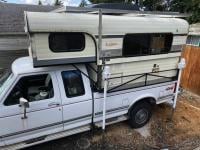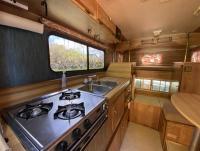I recently acquired not only my first Alaskan, but my first truck camper, and it's been quite an education, sort of a case of drinking from a fire hose. I thought I should catalog the experience for the benefit of other newbies and to give the greybeards a chance to correct my misteaks.
BC (Before camper)
I've been sleeping out in the bush for over 60 years, so there's not much I don't know about camping. However, as the years wear on the body wears out, so in 2015 I bought a Chevy Astro and outfitted it with a bed for the wife and I, and for 5 years we camped quite happily in the Chevy, logging travels for maybe 2 months of the year. In 2020 my wife Bonnie started to express displeasure with the level of comfort the Astro provides, and we decided that we needed a home where we could stand up, sit at a table, cook indoors, be warm on icy winter mornings, and generally enjoy a few well-deserved comforts. However we also wanted to retain our ability to travel rough and rocky roads to empty lands in places like Utah and Yukon, Nayarit and Nevada, and hang out there for as long as we care. So that left us with a 4WD vehicle, high clearance, probably a truck camper, and a low C of G so we could keep the rubber on the bottom. That meant a pop-up camper, and a little further review led me to Alaskan, partly because it's a very well designed and built machine, but also because I love old stuff and good woodworking and things that hold their value for good reasons. But first I needed a truck. COVID had hit a few months earlier and trucks, as well as Alaskans, were suddenly both scarce and expensive. So it took quite a bit of searching, but in March 2021 I acquired a 2013 Silverado 2500 with only 62K miles and in great shape, so then I detailed the Astro and sold it for a great price. When I got home from the Astro sale with $8K burning in my pocket, I opened up Craigslist and hallelujah, there was an 8-ft cabover Alaskan (May 1991 build), for sale 5 miles from my house, just posted. Even more oddly it was being sold by a guy I didn't know, but who's planning a clearcut behind my house. Coincidences! I was there in under an hour and after confirming that the wood was sound and the hydraulics worked reasonably well, and otherwise it was a pretty good buy, closed on it. Picked it up that evening.
At this point in the process I had learned these new things:
- Who makes pop-up campers and their relative merits, issues and costs. For instance, did you know that though Alaskans are "heavy" compared to softside pop-ups, the weight penalty is only a little over 10% for campers of equivalent cabin volume? Even less when compared to wood-framed (instead of aluminum-framed) pop-ups. Also, Alaskans hold their value better than other pop-ups, and a well cared for Alaskan will often sell for more than its original list price (if you don't correct for inflation). I think I paid about 65% of list for my 1991.
- Basic history and construction of Alaskans, what to watch out for, what's not too much of a worry to deal with, and the concept that for Alaskans (unlike pretty much any other camper) a 30-year-old camper is not, in fact, especially old, particularly if it's been well cared for.
- GVWR, fore-aft weight allocation to axles, center of gravity, weights of empty campers, weights of campers loaded with water, food, gear, people, dogs etc., what this means for suspensions, what this means for the kind of truck you need to haul this gear in safety, power and comfort. A 1500 lb dry weight camper can easily exceed 3000 lb payload weight after all personnel and gear are accounted for, and unless the vehicle is designed to readily handle such loads, substantial suspension modifications can be needed, esp. for serious high-clearance 4WD performance.
- Diesel vs. gas trucks: despite the substantially better MPGs, diesel saves no money after initial costs and maintenance costs are considered. Diesels are very heavy and this can substantially eat into your payload allowance. Diesels are best for long-haul service, with continuous use and fairly constant loads, such as pulling a heavy trailer down the Interstate; stop-and-go driving, highly variable power loads, and frequent stops that involve engine off, all favor gasoline engines. When traveling, I stop all over the place, often covering 100 miles or less before finding a place to stop for the day, so my use scenario is gasoline.
- Basics of what services the camper provides and how it does so: electrical, propane and water systems and how they interact to service appliances in various settings, i.e. boondocks, shore power and water, trailer on or off truck, solar power available or not.
- Photos show the Alaskan as it came to me
That'll do for now.















